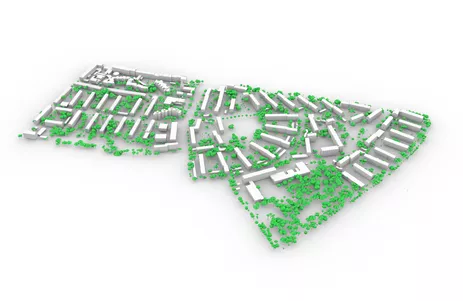SP6: Indoor Comfort and Energy Consumption of Buildings


Head: Prof. Dr. Werner Lang
Execution: Farzan Banihashemi & Roland Reitberger
Background
Human comfort, health and intellectual productivity are determined by indoor climate, as people spend almost 90% of their time indoors. Architectural approaches for creating comfortable indoor conditions throughout the year are not sufficiently effective in many regions. In contrast, technical means for heating, cooling, and ventilation lead to increasing CO2 emissions, and alternative solutions are urgently needed. This is particularly important for cities with disproportionally increasing temperatures and higher demand for cooling. Recent studies have shown that plants and greenery systems, such as trees, climbing plants, facade-integrated plant systems as well as green roofs have a positive effect on the micro-climate of surrounding buildings, but also on indoor thermal comfort and mental health. Thus, innovative UGI provides a methodology to couple both the technical and the biological realms for achieving optimal solutions for enhancing indoor thermal conditions while minimizing the buildings’ energy consumption and carbon emissions.
Objectives
In this subproject, we will examine the potential of the substitution of technical, non-renewable systems by UGI, and functional, ecological, and technical aspects will be analyzed. Based on the results, the potential for the integration of UGI into the planning of buildings and cities will be examined in the following funding period.
The objectives are to:
- (O1) Analyze the most relevant building typologies in dense inner-city environments at a neighborhood scale concerning solar exposure, outdoor comfort, air movement, and the effects on the comfort inside the buildings, setting the baseline for the following studies on integration of UGI;
- (O2) Understand the options for the integration of various types of UGI into the built environment concerning their potential to moderate the outdoor climate in summer;
- (O3) Investigate the effect of enhanced outdoor comfort through UGI on indoor climate;
- (O4) Study the potential to reduce the energy demand and CO2 emissions for heating and cooling of buildings.
We predict that:
- (H1) Building typologies in dense inner-city environments, such as point-, row- and perimeter block development, and related factors, such as density and orientation, have an immediate effect on in- and outdoor comfort and the resulting energy demand for heating and cooling;
- (H2) In addition to improving outdoor comfort through architectural means, the use of UGI can improve indoor comfort and reduce CO2 emissions from the buildings;
- (H3) The synergetic integration of architectural-technical and greenery systems allows for increasing the comfort conditions within buildings even in areas where trees cannot be planted, due to extended sealed surfaces in dense urban environments.
Methods
In the first stage of SP6, a systematic modeling approach will be developed that couples the analysis of outdoor micro-climates and their effect on indoor comfort at high spatial and temporal resolution. The results of the analysis of alternative scenarios will be used to maximize the effect of the integration of UGI and corresponding parameters of buildings, such as glazing quality and ratio, technical shading systems and balconies, loggias etc., thermal mass, floor plan, and options for cross-ventilation and night-time cooling of the corresponding building. To obtain a holistic view of the opportunities and potentials of such an approach, we will consider the environmental effects on the entire life cycle of the related systems, from construction, and operation to their deconstruction. The results will be used for an integrated approach to improve green-gray infrastructures. Furthermore, the opportunities for the operationalisation of the other strategies (substitution, integration) will be considered. Beyond the close collaboration within Cluster 2 with SP7, SP8 and SP9, a close collaboration is envisaged with the subprojects on urban biodiversity (SP1) and Transformative UGI (SP4) of Cluster 1 as well as with Effects of SUDS on Water Quality (SP10) of Cluster 3.